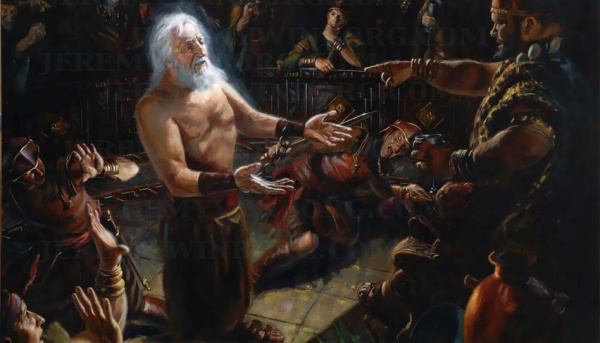Question
Gramps,
We know the Trinity is a false doctrine. God and Jesus are separate personages. But confusingly, Jesus is often referred to as “God”, especially in the Old Testament. To reconcile this, we often distinguish between God the Father (God) and God the Son (Jesus). However, in Mosiah 15, Abinadi preaches that Jesus is both the Father and the Son, which are one God. What does that make Heavenly Father? At first glance, Abinadi’s sermon seems to support the Trinity.
Justin
Answer
Justin,
In the Book of Mormon, Abinadi stands as a pivotal prophet who preaches profound truths about Jesus Christ, particularly in Mosiah 15. One of the most striking elements of Abinadi’s message is the declaration that Jesus is both the Father and the Son. This doctrine is central to the understanding of Christ’s nature in Latter-day Saint theology and invites deep contemplation on the roles Jesus plays in the divine plan of salvation.
The question of how Jesus can be simultaneously both the Father and the Son has intrigued scholars and believers alike. In Mosiah 15, Abinadi articulates this complex relationship in a straightforward yet profound manner. His teachings not only clarify the nature of Christ but also serve as a guide for understanding the dynamics of the Godhead as taught in The Church of Jesus Christ of Latter-day Saints. By exploring the dual nature of Jesus Christ, we can gain insight into His divine role and the significance of His Atonement.
Abinadi begins his discourse by establishing the divinity of Jesus Christ, stating, “God himself shall come down among the children of men” (Mosiah 15:1). This assertion underscores the belief that Jesus, in His mortal form, is indeed the Son of God. However, Abinadi does not stop there; he emphasizes that because He “dwelleth in flesh,” He shall be called the Son of God (Mosiah 15:2).
This duality speaks to the Latter-day Saint understanding that Jesus embodies both mortal and divine natures. He is the literal Son of God in the flesh, having been conceived by the power of God (Mosiah 15:3). At the same time, He possesses divine attributes that affirm His role as the Eternal Father. This complex relationship is crucial for comprehending the Atonement. As the Son, He can empathize with human suffering, and as the Father, He holds authority over the creation, providing the means for salvation.
The title of “Father” is attributed to Christ for various reasons. First, His divine conception marks Him as the Son of God. Yet, He also serves as a spiritual father to those who follow His teachings. In Mosiah 5:7, Abinadi explains that by accepting the gospel, individuals become children of Christ, thereby establishing Him in a paternal role. This highlights the nurturing aspect of His relationship with believers.
Furthermore, Abinadi asserts that “he is the Creator of heaven and earth” (Mosiah 15:4), reinforcing the notion of Christ as the Father in a creative sense. The doctrine teaches that through Jesus, all things were made, and thus He holds a paternal role over all creation. The Church teaches that while God the Father and Jesus Christ are separate beings, Jesus can be referred to as the Father in the context of His roles in creation and spiritual rebirth.
Christ is the Father by virtue of his role as the Creator of heaven and earth. He is, in effect, the Father of creation. No one would argue that He created under the direction of Elohim, but if He, as a pre-mortal Spirit, could create all things in heaven and earth, then he is, indeed, the Father of Creation. Accordingly, Samuel the Lamanite prophesied of Jesus Christ, the Son of God, the Father of heaven and of earth, the Creator of all things from the beginning (Hel 14:12, italics added). Gospel Doctrine
Abinadi emphasizes the unity between the Father and the Son, stating, “they are one God” (Mosiah 15:4). This declaration does not imply a physical oneness but rather a unity of purpose and mission. In Latter-day Saint belief, the Godhead consists of three distinct beings—God the Father, Jesus Christ, and the Holy Ghost—who are united in their divine mission. This understanding is crucial as it reflects the cooperative relationship within the Godhead as they work together for the salvation of humanity.
This concept of unity extends beyond mere titles; it encompasses the divine attributes and characteristics that Jesus shares with the Father. By understanding this relationship, believers can foster a deeper connection with Christ, recognizing Him as both their Savior and their spiritual Father. This covenantal relationship emphasizes the importance of following Christ’s teachings, as doing so acknowledges Him as the guiding Father in their spiritual journey.
The understanding of Jesus as both the Father and the Son is deeply intertwined with the covenantal relationship believers have with Him. In Latter-day Saint theology, accepting Christ’s gospel signifies a commitment to follow His teachings and enter into a sacred covenant. Abinadi’s teachings reinforce this idea by illustrating that believers are spiritually reborn through Christ, thereby establishing Him as their Father (Mosiah 5:7).
This covenantal relationship signifies more than just a title; it reflects a profound commitment to living according to Christ’s teachings. It invites individuals to participate in the divine plan of salvation, where Jesus acts not only as a guide but also as a Father who nurtures and leads His followers toward eternal life. This understanding of Christ as a spiritual Father is further supported by teachings from Church leaders, who emphasize that Jesus holds the title of Father in the context of spiritual rebirth and divine authority.
Gramps







